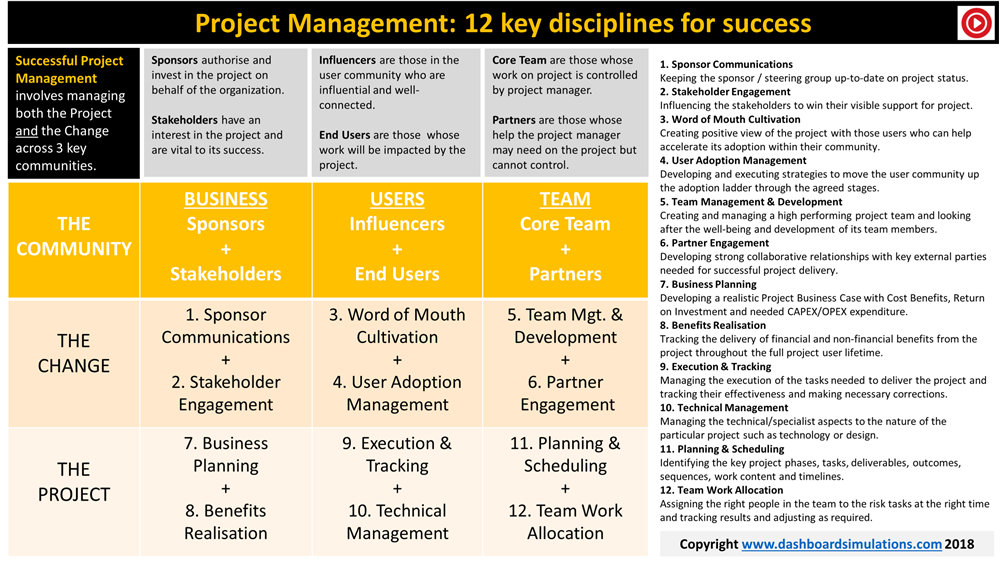What does it mean to be a Project Manager: A simple broad competency framework for learning
Although I have managed numerous types and sizes of projects over the last 30 years I am constantly flabbergasted by the fact that no two practitioners ever seem to agree what constitutes the most important aspects of “Project Management”.
Why is this important?
How can you develop a group skills in project management when you don’t have a common understanding of what you mean by the term? How can you select a training course or a business simulation game in project management when you don’t exactly know what you are looking for?
Competency Framework for Project Management
To help with this recurring problem we have developed a broad but simple model of project management consisting of 12 different potential disciplines each of which could be considered an important aspect of it. Some people when they talk about Project Management are only referring to 1 or 2 of these 12 aspects. Others may be looking at a much broader picture. Next time you are talking about “Project Management” with a colleague in L & D spend a few minutes agreeing which of the 12 disciplines you need to focus on most in that particular instance ?
The infographic below is a summary of a model which contends that successful Project Management involves managing both the Project and the Change across 3 key communities:

THIS MODEL IS EXPLAINED IN DETAIL IN OUR BOOK - A SYSTEMATIC GUIDE TO PROJECT MANAGEMENT - WITH DEDICATED SECTION FOR EACH OF THE TWELVE DISCIPLINES.
1. The Business Community
Sponsors authorise and invest in the project on behalf of the organization.
Stakeholders have an interest in the project and are vital to its success.
2. The User Community
Influencers are those in the user community who are influential and well-connected.
End Users are those whose work will be impacted by the project.
3. The Team Community
Core Team are those whose work on project is controlled by project manager.
Partners are those whose help the project manager may need on the project but cannot control.
12 Key Project Management Disciplines
Across these 3 communities there are 12 main disciplines - 4 per community with each one classified as either primarily to do with the Project or primarily to do with the necessary Change Management:
1. Sponsor Communications: Keeping the sponsor / steering group up-to-date on project status.
2. Stakeholder Engagement: Influencing the stakeholders to win their visible support for project.
3. Word of Mouth Cultivation: Creating positive view of the project with those users who can help accelerate its adoption within their community.
4. User Adoption Management: Developing and executing strategies to move the user community up the adoption ladder through the agreed stages.
5. Team Management & Development: Creating and managing a high performing project team and looking after the well-being and development of its team members.
6. Partner Engagement: Developing strong collaborative relationships with key external parties needed for successful project delivery.
7. Business Planning: Developing a realistic Project Business Case with Cost Benefits, Return on Investment and needed CAPEX/OPEX expenditure.
8. Benefits Realisation: Tracking the delivery of financial and non-financial benefits from the project throughout the full project user lifetime.
9. Execution & Tracking: Managing the execution of the tasks needed to deliver the project and tracking their effectiveness and making the necessary corrections.
10. Technical Management: Managing the technical/specialist aspects specific to the nature of the particular project such as technology or design.
11. Planning & Scheduling: Identifying the key project phases, tasks, deliverables, outcomes, sequences, work content and timelines.
12. Team Work Allocation: Assigning the right people in the team to the risk tasks at the right time and tracking results and adjusting as required.
Project Management Simulations and Blended Learning.
In my experience no single business simulation/game can do justice to all 12 aspects of the model. This is why you really need to decide what the most important aspects of “Project Management” are for each particular situation.
Even if a simulation covered all 12 topics it would probably be quite a 1-dimensional learning experience so what I recommend, consistent with best practices in Blended Learning, is to pick a simulation which covers the highest priority project management topics and to complement it to address the other topics using role-plays and off-sim exercises.
Therefore, referring to the 12 disciplines model above
- If your focus is mostly on the Team column of the model you might consider simulations like CREW or CHAPTER or FUSION.
- If your focus is mostly on the User column of the model you might consider project simulations like SPREAD.
- If your focus is mostly on the Business column of the model you might consider simulations like PLAY-IT or COHORT.